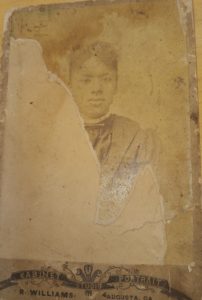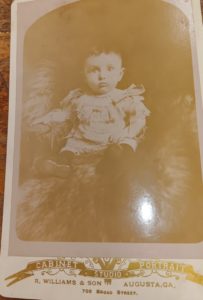Thanks to the generosity of Mr. Joseph M. Lee., the Georgia Room has a small collection of studio portraits, taken by various studios which conducted business in Augusta in the late 19th and early 20th centuries. As a document of Augusta photography studios, the photographs are very interesting.
One studio stands out, the studio of Robert Williams, later to be known as R. Williams and Son. These photographs document the work of Robert Williams and his son Robert E. Williams. Robert Williams is credited with being the first African-American professional photographer in Augusta.
The first city directory entries to document a Williams association with photography places Robert E. Williams working in 1877 for the photographer J. Usher. Robert E. was listed as working for Usher in 1882 as a printer. In 1883-1886 Robert E. is listed as a photographer though a second Robert Williams appears in the listing from 1886. However, no business address is given so it is possible to conjecture that the Williamses worked out of their residence on 1002 South Boundary.
However, in 1888, Williams opened his own photography studio documented by the city directories as being at 705 Broad Street. It appears he worked here alone until he was joined by his son Robert E. in 1892. The business appears to have been renamed as R. Williams and Son sometime around 1895. Another useful piece of information is provided in 1902; the name of Robert’s wife is Amelia, the name of Robert E.’s wife is Anna.
In 1904, the address of the studio changed to 707 Broad Street. A change of address may have been necessary for the expansion of the business. Williams’ studio did developing work for amateur photographers. The Eastman Kodak company’s introduction of roll film combined with the box camera in 1888 created a wave of amateur photographers and Williams advertised for his share of this work. A March 30, 1904 classified ad in the Augusta Chronicle states, “We [Do] developing for amateur photographers; best work, lowest prices; R.Williams & Son, 707 Broad.” This address lasted until approximately 1907 when the business shares space with A. A. Pelot, formerly Pelot and Cole, at 648 Broad Street.
Informed speculation suggests that prior to this association with Robert Williams & Son, Alma A. Pelot had been in partnership with James D. Cole. In a Augusta Chronicle article, dated May, 21, 1899, noting the thirty-fourth anniversary of the studio of Pelot & Cole, it was stated “..there is not a family…that has not had a representative before the camera of Mr. Alma A. Pelot to sit for a negative that grew to lifelike resemblance under the artistic touch of Mr. James D. Cole.” This implies that Pelot was the camera man of the business and Cole was in charge of developing, retouching, and tinting the pictures. Between 1903 and 1904, Cole apparently became too ill to work in the business. He filed for a Confederate pension in August 1904 stating that he had no assets and was unable to work. He died sometime in 1907 or 1908 according to a listing of deceased Confederate veterans published in the Augusta Chronicle on April 28, 1908. Perhaps the Williamses had a need for a new business address and this coupled with Pelot’s possible need for an associate who could develop film and make prints probably led to the sharing of 648 Broad. Pelot’s death on December 13, 1909 probably influenced the Williamses to return to working from home in 1910 as the city directories imply.
There is also some evidence that this event may have been a catalyst for retirement. The 1910 US census lists Robert and Robert E.’s profession as retired photographer. However, Robert E. did not remain retired for long. The city directory notes that in 1912 Robert E. noted his occupation as photographer working with a relative Robert E. Jr. That may or may not have been Robert E’s son. This entry does not appear again in the city directories. A Robert C. is listed as a grandson in the 1910 census with Robert as head of house and Robert E. as a son. The 1920 and 1930 census lists Robert E as head of house and Robert C. as a son.
The family had a habit of its members residing at the same address. Robert and Robert E. had shared an address at 1002 South Boundary, and at 1102 Turknett Springs Rd. By 1913, Robert E. was showing 1102 Wrightsboro Rd. as the home address and this address was occupied by Anna Williams and Robert C. Williams after his death according to the city directories. He claimed employment as a photographer from this address in 1915, probably 1919 if he is erroneously listed as Robert A., and 1925. Other years, the Robert E. of 1102 Wrightsboro tried his hand at carpentry, real estate, and as a salesman for the South Finance Company. According to the 1920 census, he was listed as a pigeon fancier whose industry was selling pigeons. To further tangle this timeline of relationships and professions a Robert B. Williams makes an appearance in the city directories as a photographer from 1913-1917 before choosing another trade.
However, it is correct to state that Robert E. Williams continued to live at 1102 Wrightsboro Rd. until his death on January 6, 1937. His death certificate shows the same address. His parents are listed as Robert Williams and Amelia Summerville corroborating our city directory information.
If we can believe the veracity of our timeline up to 1910, we can put tentative dates on the photographs from the Lee collection. Material created by Robert Williams once he established his studio ranges from 1888 to approximately 1894. Material created by R. Williams and Son ranges from 1895 to 1908. It appears that both men worked from home at 1102 Turknet Springs Rd. In 1910, the year that the census reports both men as retired photographers, Robert Williams city directory entry does not list his employment but Robert E. Williams is still listed as a photographer.
The photographs from the Lee collection are studio portraits of individual men, women and children. The subjects are both African-American and white. It leads us to speculate that the quality of his photographs transcended the prejudice that might exist in business dealing with the general public. On the back of a photo in the collection we have evidence that Williams could occasionally use his finished photographs to advertise other services, in this case by the words “Old Pictures Copied”. He tried several watermarks before settling on a consistent label to represent R. Williams & Son. A pencil inscription on the back of one image identifies the sitter as Julia Herndon with the date of Aug.1886. The watermark on the back of the item shows an address 705 Broad Street. Given the data from the city directories, and the Rob’t. Williams & Son watermark, the date attributed to this photograph is probably incorrect.
If a picture is worth a thousand words, than the Williams work says much more about them than the little biographical information we have been able to gather.
A collection of photographs taken by Robert E. Williams can be found at the Digital Library of Georgia. Robert E. Williams Photographic Collection: African-Americans in the Augusta, Ga. Vicinity (Richmond Co.), circa 1872-1898 can be viewed through this link https://dlg.usg.edu/collection/dlg_zlrw . These candid shots stand in contrast to the formal studio work and show a different aspect of the photographer’s art.
Together the photographs and timeline contribute to a story of two African-Americans who sustained a 22-year-old business through application of their artistic talents. Even though the rest of their story waits for more evidence to flesh it out, one can appreciate the history they have preserved for us though their application of the photographer’s lens.


